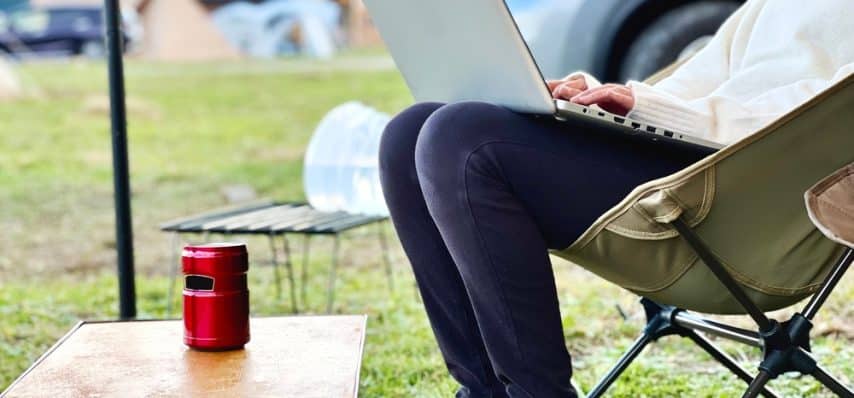Why Now’s the Time to Start Your Own Glamping Business (and a Quick Guide to Get Started 
Do you own a piece of land with extra acreage? Do you have a background in customer service, or at least enjoy helping others? Have you ever wanted to run your own business? If so, opening a “glampground” might be for you.
What Is Glamping?
Glamping, in a nutshell, is the cross between traditional camping and staying in a hotel, inn, or resort. It combines the best of both worlds: The closeness to nature that camping provides with all (or at least most, depending on the location) of the creature comforts a hotel room has available — running water, electricity, a REAL bed… Some “glampsites” even have their own kitchenette!
As you have probably figured out by now, the name “glamping” is a mash-up of “glamorous” and “camping.” And it is just that. It is a bit like RVing in that you still have access to running water on-site, your own shower, and a leak-proof place to escape from the rain. Plus, you get to bypass the not-so-fun parts of traditional camping, such as buying all of the gear, setting up your tent and campsite, and dealing with bugs. You’re starting to see the appeal, right? So are many other people.
Glamping Trends
Although a relatively new trend in the outdoor recreation world, glamping is showing growth through at least 2024. According to the recent Arizton report, the glamping industry is expected to reach a $1 billion revenue by 2024. That’s a growth rate of over 15%.
For camping in general, more and more people are heading out to the woods each year. According to Forbes.com, more than six million new households have started camping since 2014.
If that’s not enough to pique your interest, eco-tourism has been on the rise for the past several years and is projected to continue rising as well as vacationers opting for “staycations” to save some time and money.
More and more people are opting for glamping experiences, but why?
Why Campers Want to Glamp Instead
As you can imagine, there are endless reasons why more people are choosing to go glamping instead of traditional camping or staying at a hotel. Let’s look at a few:
• People want nature to be right at their door, but usually do not enjoy camping and prefer to stay in a hotel while traveling/vacationing.
• People do not want to deal with the storing of camping gear at home and setting all of it up themselves while camping.
• Although the economy is relatively good at the moment, people are still wanting to spend less on their vacation accommodations. Hotel prices are getting out of hand just about everywhere.
• Tourists want a personalized experience. At many glamping locations, the hosts offer extras, such as breakfast, clean towels every day, and Wi-Fi. Glamping is basically like a bed and breakfast for the outdoor lover. Some places are even offering farm tours, hiking trips, and yoga workshops.
• People want unique accommodations for their stay. Glamping shelters are just about limitless in possibilities. Some main ones include yurts, cabins, tipis, safari tents, treehouses, and even converted hog sheds!
So, what exactly do you need to start your own glampground? Let’s talk about some basics.
A General List of What You Need to Get Started in Glamping
Admittedly, starting your own glamping business from the ground up can be a lot more scary, costly, and risky than, say, starting your own primitive campground. However, the sky is the limit for how much you want to charge for your glampsites and what’s going to be your draw to tourists (more on that in a second).
• Some extra land. Obviously, you’ll need some extra land you can construct your glampsites on. This doesn’t have to be a lot, on the same property where you live, or even in the countryside. In fact, glamping destinations near urban areas are in demand. So long as you have the space, can run the necessary utilities, and have the proper permissions, you are good to go.
• Know your customers. Or at least who you think your customers will be. It might seem silly trying to envision imaginary customers, but it’s an important step. Do you think you’ll have more families visiting or couples? Keep in mind the type of customers you want to attract too. Profitable or not, you’ll be miserable if you end up running a family-friendly glamping business if you can’t stand kids. The type of people you want to attract ties in nicely with our next point…
• Pick a theme. Although it sounds arbitrary, this is very important, especially when it comes to glampgrounds. It’s even more important to those who may not have the added perk of being located near an extra scenic place or national park. You don’t need to be located near a special place to run a successful glamping business, but you must have something that makes your glampground unique and draws people in.
Think of the way bed and breakfasts decorate each of their rooms differently. More than likely, one is going to appeal to you more than another. The same goes for glampgrounds and even individual glampsites within the same glampground. You can still decorate each shelter within your glampground with the same theme in mind, but they don’t have to be exactly the same.
For instance, let’s say you live on a small farm and decide on a farm theme. That doesn’t mean you have to have chicken decor everywhere in each of your shelters. You could have chickens and nesting box dressers in one, cow pictures and milk crate dressers in another. You get the idea.
• What kind of structures do you want? This is another very important question in the planning phase. What can you afford? What is the feel you are going for? How durable are they? What will appeal to your customers? These are all vital questions to ask yourself.
• Make a plan. Other than deciding on what type of structures you would like to build or purchase, you need to decide on what amenities you will offer. Will you need to up your internet speed/data usage? How much will it cost to run extra electric wires and plumbing out to your units? Research all of the utilities/amenities in-depth and make a budget for your business.
• A desire to provide a fun, enjoyable, and relaxing experience. Sure, you want to make money and be your own boss, but if you don’t at least like being around other people, a glamping business will probably not make you happy.
• Check out zoning/permissions for your area. Make sure you’re allowed to build the kind of structures you desire and run all of the utilities to them before you jump in headfirst. In other words, cover all of your legal bases.
• Insurance. Once the ball gets rolling, make sure you have the right kind of insurance coverage for your new business. Cover the structures and any damage that may come to your shelters, whether natural or man-made. Also, speaking of technical stuff, start thinking about a liability waiver for clients to sign before their stay. You don’t want someone suing you for tripping over a rock and rolling their ankle. You just never know nowadays.
• Extras: Will you offer them and if so, what kind? Again, the more unique and personalized a glamping experience is, the more people you will draw to your business. Do you live on a farm? Offer a tour of your property, let them meet your animals, and even let them experience some of the things you do each day to keep the place running smoothly.
Do you have a pond or lake on your property? Rent out paddle boats, canoes, or kayaks (or include it in the cost of their stay).
• Promote, promote, promote. With all of the technology available to us nowadays, it’s easier than ever to promote your business. Set up a website. It doesn’t have to be fancy; just enough to pique people’s interest and answer any questions potential customers might have. Be sure to get listed on glamping websites, such as Glamping Hub. It is also a good idea to connect with local businesses and publications. Run some ads. Join some Facebook groups. The promotional possibilities are limitless!
Pro Tip: Offer a discount to the first X many customers. This is a ploy Hipcamp suggests its new users try to get customers (and reviews!) rolling in. No one can pass up a good bargain!
What Are You Waiting For?
As you can see, there are a lot of things to think about when it comes to planning a glamping business, or even deciding if it is the right choice for you. Try not to get overwhelmed, though. Setting up your glamping business can be as fancy or low-key, expensive or cost-effective as you want.
Visualize your perfect glamping set-up and your daily tasks of making it run smoothly. Can you see yourself still enjoying it 10, 20, or even 30 years from now? Do you get excited thinking about what the future could hold? If so, a glamping business may be for you.



